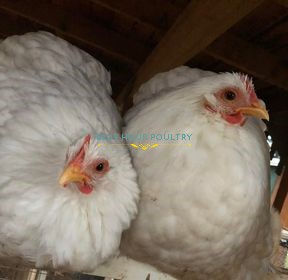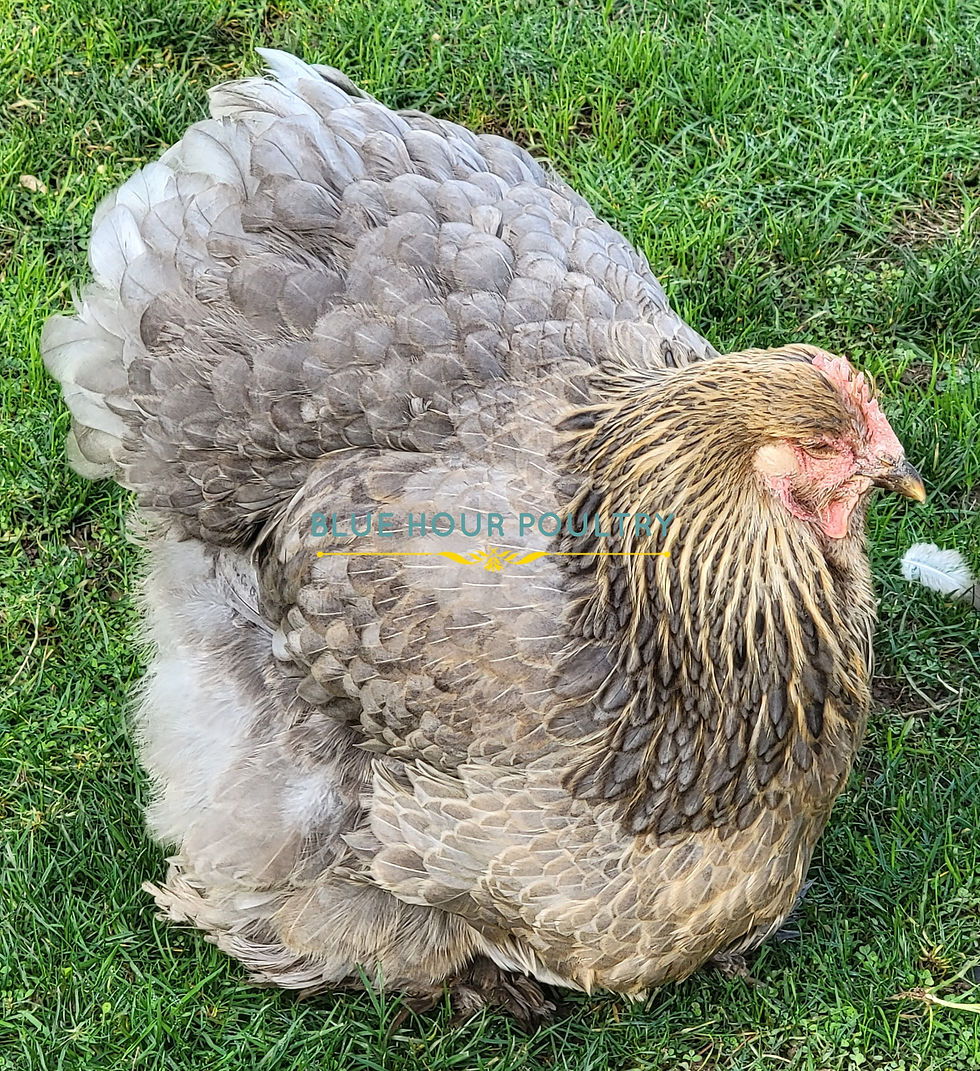The Bobtail Cochin
- Robert Anderson
- Mar 9, 2022
- 6 min read
By Bob Anderson, Blue Hour Poultry
March 9, 2022
Not many years ago from a small flock of exhibition Black Red Cochin Bantams in Germany arose some altogether not Black Red offspring. The females came in an intriguing color combination with a ghostly gray body with white hackle; the males a dirty white. In the 1990s, when these birds first appeared, it was not clear whether this color was a spontaneous mutation or a new combination of recessive genes lying just below the surface. What was clear is that these birds appeared to be the only ones of their kind, a new and beautiful color variety that soon became known as the Bobtail Cochin. They captured the imagination of Cochin fanciers both in Europe and North America.
Contrary to what the name suggests, the Bobtail is not sans tail – it is no Manx Rumpy. It comes replete with all of the usual appendages, including the uropygium and tail retrices. Its name, instead, appears to be an homage to the Old English Sheepdog which is known as the Bobtail, in the common vernacular, for its similar color breaks of white and gray.
When the Bobtail Cochin Bantam made its way to the US, it wasn’t long before rumors spread of its ability to improve the type and mass of feather on nearly any color it was crossed with, appearing to possess an almost magical quality of improving anything it touched then vanishing as if it had devoured itself in the process. There were tales of Buff Columbian Bantams being crossed with Bobtail and the offspring coming a much better version of Buff Columbian Cochin, with more feather and better type than the Buff Columbian parents. If all of this is true, this would act like no other gene we have experienced to this date.
In Europe, early test matings showed that Bobtail to Bobtail would breed true to color reliably and predictably. Test matings of Bobtail against other color patterns revealed interesting results in the F2 generation. In many cases, the birds that reappeared with the ghosting of the Bobtail progenitors expressed the color in a different way – in other words, not Bobtail.
More recently in the US, the notoriety of the Bobtail has spurred its use in a number of project outcrosses – including both Wheaten and Red – with the breeders reporting in the second generation that they are seeing a percentage of Partridge-looking chicks. So, how is all of this possible and what is actually happening?
It is useful here to start at the beginning, by understanding the German Black Red Cochin. There is no direct translation of Black Red between the German and US Standards. When Americans hear Black Red we tend to think of either Black or Brown Red, neither of which applies here. Black Red in common usage among the Game breeders is short for Black Breasted Red or Red Duckwing – the wild pattern. The Duckwing (e+) e-allele is not native to Cochins, but the closest counterpart visually is the Brown (eb) e-allele upon which Partridge is based. Brown has a couple of interesting characteristics: 1. It works very well with patterns and 2. It is almost always recessive to other e-alleles. Brown is the e-allele, for example, that the Columbian pattern is built upon. When there is no patterning gene present birds with the Brown e-allele very closely resemble the Black Breasted Red Old English. In the US we would think of them as the male exhibition line of Partridge Cochin and our closest recognized counterpart is the Brown Cochin – the Brown (US) being darker while the Black Red (German) carries dilution factors that lighten the hackle.
It is not uncommon for Cochins of all color varieties to carry Recessive White (c) as an artifact of the way the breed standard was written – requiring even Black birds to have yellow legs. Recessive White in one dose does, in fact, have the effect of limiting deposition of melanin in the shank and thus yellowing the leg color. Dr. Carefoot (UK) even noted in his book “Creative Poultry Breeding” that he believed the best Partridge all carried Recessive White as a means of brightening their top color.
In his book “An Introduction to Color Forms of the Domestic Fowl”, Brian Reeder (US) notes, “…there are two genes which create a recessive white phenotype. One is more effective than the other as the less effective form has less effect on autosomal pheomelanin, allowing it to show up on eWh and e+ background genomes”. In other words, the non-exhibition form allows for a “ghosting” of the red pigment from the underlying pattern. The exhibition form covers the underlying pattern more completely and is annotated as c/c when homozygous. In other words, we often speak of the recessive white mutation as if it was a single mutation at a point in time but there is more than one allele of this gene, and we cannot rule out that there might be others.
Recessive White is considered to be a dilution factor and an upstream inhibitor – essentially blocking pigmentation of the feather during feather growth, regardless of what the underlying pattern may be. It is inherited as an autosomal recessive, so both males and females require two copies in order for Recessive White to express itself. It is also, to some extent, sex-expressed in that the hackle, saddle and wing bow of the male have more of a tendency to show bleed through of the underlying pattern likely due to hormonal and feather structure differences.
Based on what we know of the history of the Bobtails, the history of the Cochin breed, and how the Bobtails have reproduced in test matings over time it now appears that what we call the Bobtail (phenotype) is a combination of two recessive genes – one being the Brown (eb) e-allele and the other a form of non-exhibition Recessive White. What makes the Bobtail form of Recessive White unique is that it is allowing expression of eumelanin (black), whereas the other known forms of Recessive White either allow some expression of autosomal pheomelanin (red) or, in the case of exhibition Recessive White, a small amount of black ticking but not in any way or to any extent that would be considered a pattern.
This would explain why the Bobtail crossed with Buff Columbian produces Buff Columbian – Buff Columbian is on a recessive Brown (eb) e-allele as is Bobtail, the Columbian gene is dominant, and the Bobtail White gene is recessive. It also explains why the breeders in Europe noted that Bobtails outcrossed to other colors do not necessarily reproduce the Bobtail phenotype. And why breeders using the Bobtail to improve their Wheatens notice Partridge-looking chicks two generations out as the Brown (eb) e-allele is recessive to Wheaten.
It is worthy of note here that a Bobtail mimic could be created on a Wheaten base using Silver and Blue, and the males of this genotype would be much more in keeping with clear and bright colors we expect in exhibition quality animals. To my eye, the female Bobtails are quite attractive, but the males are an unfortunate shade of dirty white.
As a practical matter for breeders planning to use the Bobtail to improve their other color varieties, it should be noted that you will be breeding in two recessive genes which may or may not be compatible with the color they are being crossed with and will require several generations to remove. In addition, it is not clear whether the improved mass of feather from the Bobtail is the result of quality breeding or is somehow tied to the Bobtail White gene itself. For practical purposes this matters because breeders using the Bobtail to improve feather quality in other colors will eventually want to remove the recessive Bobtail White genetics while maintaining improvements in feather quality and type.
How to improve the Bobtail or add new genetics without destroying the pattern is a concern as there is no equivalent of the Black Red Cochin Bantam readily available in the US. Partridge would be the closest and, incidentally, Partridge may also benefit from this cross. More intriguing, though, is what might be uncovered from the Bobtail – the long mysterious Brown Cochin Bantam which is recognized in the US but never seen, lies just below the surface and perhaps some industrious and skillful breeder will pick up that project and run with it.
I am certain that in the coming years we will learn much more about the Bobtail Cochin and its genetics. Afterall, no progeny testing has been performed, to my knowledge, against other forms of Recessive White. I have seen ponderings online about how it might be a mysterious form of albinism. For now, all evidence indicates a form of autosomal Recessive White on a non-patterned Brown (eb) e-allele. I am posting three photos on the Blue Hour Poultry blog version of this post. The first of these is a large fowl homozygous Brown hen with both Blue and Dilution, which would be similar to the Black Red (or in this case Blue Red) of Germany. The other two photos are of a friend’s Bobtail Cochin Bantam female. I do hope you enjoyed this article and that I have contributed to the Cochin community and your thinking about the Bobtail Cochin.









Comments